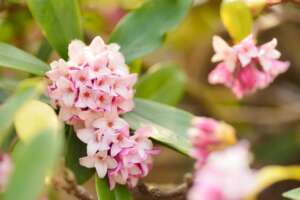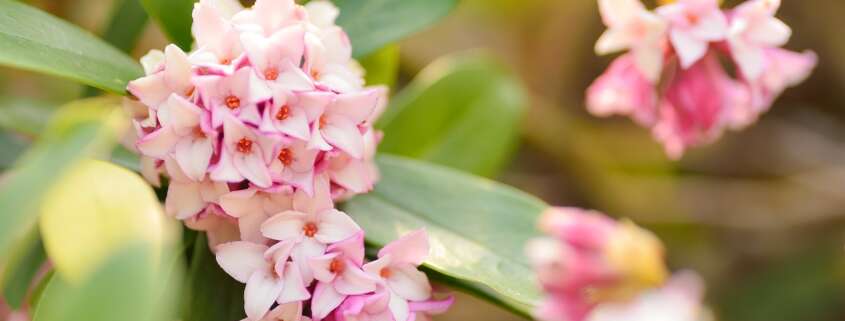Fragrant Daphne. Winter plants
Native to Asia, Europe and North America, Fragrant Daphne is often grown as an ornamental shrub in gardens.
Fragrant Daphne
We know its cousin a little better, Daphne mezereum which is a small shrub from the Thymelaceae family, approximately 1.20m high and 80cm wide.
The fragrant Daphne is native to the Far East, mainly China and Japan. This plant was introduced to Europe in the early 19th century, where it quickly gained popularity due to its fragrant flowers and evergreen foliage.
Fragrant Daphne grows naturally in mountain forests, often on wooded slopes. It is well adapted to temperate climates and appreciates a partially shaded exposure. This plant has been widely grown for ornamental use in gardens because of its attractive characteristics, particularly its winter flowering which adds color and fragrance during a time when many other plants are dormant.
What does fragrant Daphne look like?
Fragrant Daphne keeps its green leaves all year round. There are several species and varieties, but most are medium-sized shrubs, usually reaching between 60cm and 1.5m in height. It is therefore perfect for growing in pots.Daphne’s most distinctive feature is winter flowering, often from January to March, depending on the region. The flowers are small, star-shaped, and give off a sweet, intoxicating scent that can fill the garden, especially in warmer weather.Its flowers can vary in color, from pale pink to purple and white. The most common varieties have pink undertones.After flowering, the plant can produce red, orange or purple berries, adding extra interest to its decorative side.Daphne thrives in well-drained soils and prefers a partially shaded exposure. It may be sensitive to excess humidity.All parts are toxic if ingested, so be sure to plant it in a location where there is no risk of ingestion by children or animals.

Daphne odora
Scent…
The scent of Fragrant Daphne is due to the presence of volatile organic compounds in its flowers. Specific scent components may vary slightly from plant to plant, but in general, Daphne odora is known for its sweet, floral, intoxicating scent.The compounds responsible for this distinctive scent often include terpenoids, phenylethyl alcohols and esters. These chemicals are produced by the plant to attract pollinators, such as insects, which help with pollination.Phenylethyl alcohol, in particular, is often associated with sweet floral notes and is frequently present in the natural fragrances of various plants. Esters, on the other hand, can add fruity or sweet notes.The complexity of the scent of a plant like Daphne odora results from the combination of numerous volatile compounds in different concentrations. The unique combination of these compounds creates the distinctive scent that makes our winter star so popular in gardens.
Visited by insects?
Although insects are generally less active in winter, some may still be present to take advantage of the nectar and help with pollination. The main pollinators of Daphne odora can include certain types of bees, including solitary bees and honey bees. The condition is mild weather, above 10 degrees.Some bumblebees may also be active during warmer periods of winter and assist in pollination.There are winter butterfly species that may be active in warmer weather and visit Fragrant Daphne flowers to feed.You may also encounter some types of flies, including pollinating flies.Although the frequency of pollinator visits in winter may be less compared to warmer seasons, Daphne odora is adapted to attract and benefit from these winter pollinators.




Leave a Reply
Want to join the discussion?Feel free to contribute!